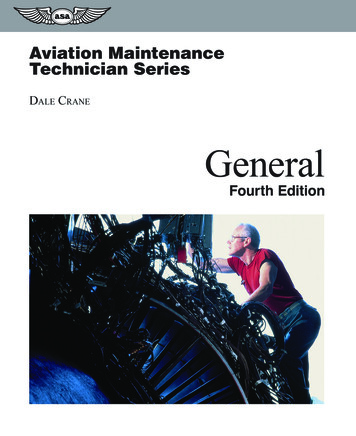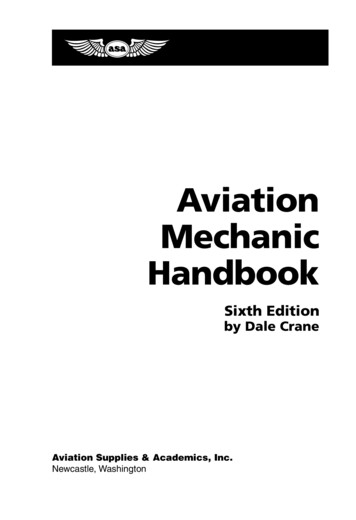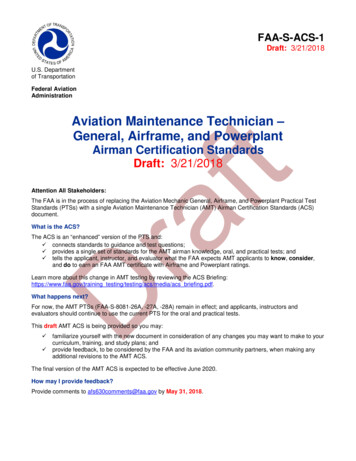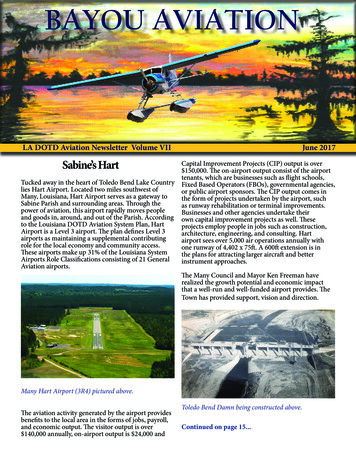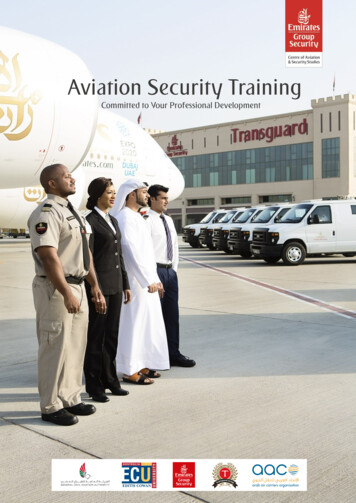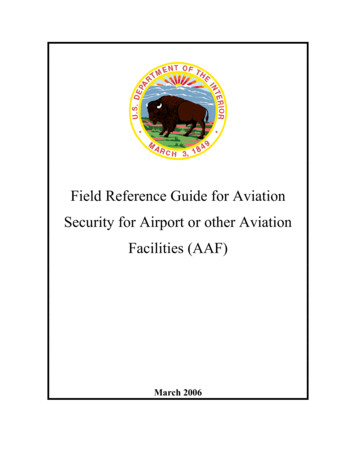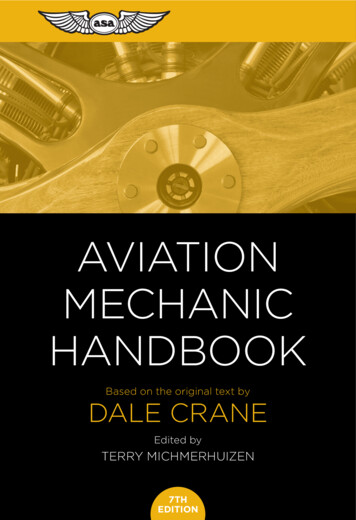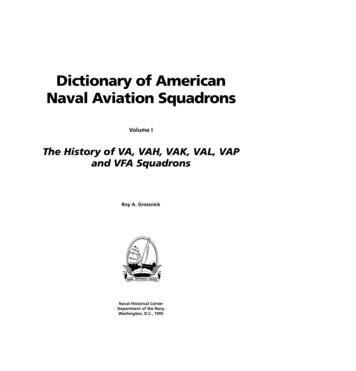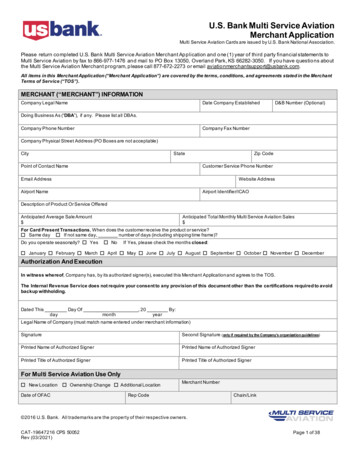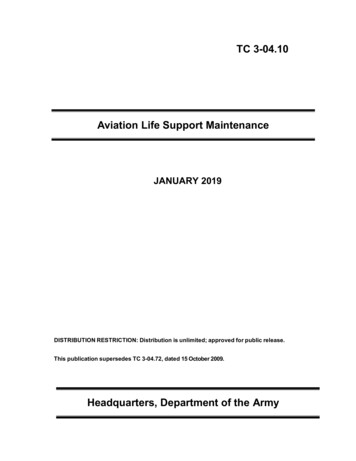
Transcription
TC 3-04.10Aviation Life Support MaintenanceJANUARY 2019DISTRIBUTION RESTRICTION: Distribution is unlimited; approved for public release.This publication supersedes TC 3-04.72, dated 15 October 2009.Headquarters, Department of the Army
This publication is available at theArmy Publishing Directorate site (https://armypubs.army.mil),and the Central Army Registry d).
*TC 3-04.10Training CircularNo. 3-04.10HeadquartersDepartment of the ArmyWashington, DC, 24 January 2019Aviation Life Support MaintenanceContentsPagePREFACE. vINTRODUCTION . viiChapter 1AVIATION LIFE SUPPORT SYSTEM . 1-1Management Evolution . 1-1Equipment Evolution . 1-1Chapter 2AVIATION LIFE SUPPORT SYSTEM MANAGEMENT PROGRAM . 2-1Section I – Program Administration . 2-1Aviation Life Support System . 2-1Aviation Life Support System Facility . 2-1Aviation Life Support Equipment . 2-1Equipment Maintenance . 2-1Section II – Personnel Responsibilities . 2-2Commanders . 2-2Aviation Life Support Officer . 2-3Aviation Life Support Equipment Technician. 2-3Aircrews . 2-4Section III – Budget Management . 2-4Section IV – Maintenance . 2-5Program Management . 2-5Program Scheduling . 2-6Automation . 2-6Inspections . 2-7Graphics Displays . 2-8Logistics and Maintenance Assistance . 2-9Section V – Reference Materials and Administrative Management . 2-10Reference Library . 2-10Technical Library . 2-10Maintenance Library Update . 2-10Publications Agencies . 2-11Changed, Revised, or Rescinded Publications . 2-11Interservice Publications Accounts . 2-11Maintenance Management Files . 2-11Electronic Publications . 2-12Section VI – Equipment Accountability, Responsibility, and Control . 2-12Accountability and Responsibility . 2-12Distribution Restriction: Distribution is unlimited; approved for public release.*This publication supersedes TC3-04.72, 15 October 2009.i
ContentsAmmunition and Explosives Control . 2-12Lock and Key Control . 2-12Accountability and Control Specific to Aviation Life Support Equipment . 2-12Section VII – Deployment Plan . 2-13Section VIII – Aviation Life Support Equipment Retrieval Program . 2-14Chapter 3SUPPLY AND MATERIEL MANAGEMENT . 3-1Section I – Supply Publications and Forms . 3-1Information Sources . 3-1Forms . 3-2Section II – Supply Procedures . 3-2Supply Classes . 3-3Authorized Repair Parts Stockage . 3-3Administration . 3-4Documentation . 3-5Requisition . 3-6Section III – Automated Supply Management . 3-7Global Combat Support System-Army . 3-7Roles and Permissions . 3-7Type Unit Code . 3-8Supply Operations Assessments . 3-8Section IV – Logistics Support Activity . 3-8Logistics Integrated Database . 3-8Publications Module . 3-9Maintenance Module . 3-9Retail Demands Module . 3-9Item Information Module . 3-10Support Item Requirements Data . 3-10Pipeline Module. 3-10Chapter 4AVIATION LIFE SUPPORT EQUIPMENT SHOP . 4-1Contents . 4-1Location . 4-1Work Area . 4-1Storage Area . 4-2Fitting Area . 4-3Office Space . 4-3Support Equipment . 4-4Environmental Control . 4-4Personal Hygiene . 4-4Shop Safety. 4-4Chapter 5AVIATION LIFE SUPPORT SYSTEM AND SURVIVAL TRAINING PROGRAMS . 5-1Overview . 5-1Responsibilities . 5-1Aviation Life Support System Training Program . 5-1Overwater Survival Training . 5-2Destruction of Equipment to Prevent Enemy Use . 5-2Appendix AALSS MAINTENANCE MANAGEMENT AND TRAINING SOP. A-1Appendix BTOOL LIST . B-1Appendix CINSPECTION CALENDAR . C-1GLOSSARY . Glossary-1REFERENCES. References-1iiTC 3-04.1024 January 2019
ContentsINDEX . Index-1FiguresFigure 4-1. Sample work area . 4-2Figure 4-2. Sample storage area. 4-2Figure 4-3. Sample fitting area . 4-3Figure 4-4. Sample office space. 4-3Figure 4-5. Sample support equipment . 4-4TablesTable 2-1. Sample budgeting and maintenance scheduling process . 2-5Table 2-2. Sample ALSE status board . 2-9Table 3-1. Supply classes . 3-3Table A-1. Sample ALSS SOP .A-1Table B-1. Tool list .B-1Table C-1. Sample 90-, 120-, 180-, and 360-day inspection calendar . C-124 January 2019TC 3-04.10iii
This page intentionally left blank.
PrefaceTraining Circular (TC) 3-04.10 provides technical information concerning aviation life support system(ALSS) management and training programs.The principal audience for TC 3-04.10 is all members of the profession of arms. Commanders and staffs ofArmy headquarters serving as joint task force or multinational headquarters should also refer to applicablejoint or multinational doctrine concerning the range of military operations and joint or multinational forces.Trainers and educators throughout the Army also use this publication.Commanders, staffs, and subordinates ensure that their decisions and actions comply with applicable UnitedStates, international, and in some cases host-nation laws and regulations. Commanders at all levels ensurethat their Soldiers operate according to the law of war and the rules of engagement. (See Field Manual [FM]27-10.)TC 3-04.10 uses joint terms where applicable. Selected joint and Army terms and definitions appear in boththe glossary and the text. Terms for which TC 3-04.10 is the proponent publication (the authority) areitalicized in the text and are marked with an asterisk (*) in the glossary. Terms and definitions for which TC3-04.10 is the proponent publication are boldfaced in the text. For other definitions shown in the text, theterm is italicized and the number of the proponent publication follows the definition.TC 3-04.10 applies to the Active Army, Army National Guard/Army National Guard of the United Statesand United States Army Reserve unless otherwise stated.The proponent of this publication is the United States Army Aviation Center of Excellence; the preparingagency is the Directorate of Training and Doctrine, United States Army Aviation Center of Excellence. Tosend comments and/or recommendations for change, use Department of the Army (DA) Form 2028(Recommended Changes to Publications and Blank Forms) found on the United States Army PublishingDirectorate website. Comments may be e-mailed to the Directorate of Training and Doctrine l, or mailed to Commander, USAACE, ATTN: ATZQTDD, Fort Rucker, Alabama 36362-5263.24 January 2019TC 3-04.10v
This page intentionally left blank.
IntroductionThis TC and Army Techniques Publication (ATP) 3-04.7 provide techniques and procedures for aviationmaintenance as the foundation for commanders, aviation life support equipment officers (ALSOs), aviationlife support equipment noncommissioned officers (ALSNCOs), and aviation life support equipmenttechnicians (ALSETs).Army Regulation (AR) 95-1, AR 95-20/DCMA INST 8210.1C/AFI 10-220 IP/NAVAIRINST3710.1G/COMDTINST M13020.3A, FM 3-04, and ATP 3-04.7 provide information on Army aviationstructure, relationships, and command, control, and communications concepts. These publications areavailable on the Army Publishing Directorate's website at https://www.armypubs.army.mil/.24 January 2019TC 3-04.10vii
This page intentionally left blank.
Chapter 1Aviation Life Support SystemThis chapter provides a brief history of the developmental evolution of the ALSS. Italso details the importance of aviation life support equipment (ALSE) to aircrews andpassengers.MANAGEMENT EVOLUTIONALSS program management has evolved from a basic vision of establishing dedicated, safetyenhanced Army aviation equipment to a program of overarching components within a life support system.The guiding theory originally focused on ever-advancing equipment for aviators; however, it soon developedinto the management of an entire system encompassing not only personal equipment but also the componentsystems dedicated to individual aircraft. The Air Warrior (AW) program was developed from thisevolutionary process. This program includes current and future development of state-of-the-art equipment toenhance safety and provides crewmembers with situational awareness and functional yet comfortableequipment.EQUIPMENT EVOLUTIONAW implementation and fielding evolved in distinct generations as new equipment became available.Descriptions of the first three AW generations are provided in the following paragraphs.AIR WARRIOR GENERATION ONEAW generation one provided an initial system capability that included the development, procurement,and fielding of: Flexible body armor. Ballistic upgrade plates. Primary survival gear carrier. First aid items. Universal holster. Aircrew survival and egress knife. Microclimate cooling system (including microclimate cooling garment and cooling unit). Overwater mission equipment (including overwater gear carrier, survival egress air, and flotationcollar).AIR WARRIOR GENERATION TWOAW generation two technology provided additional capabilities that included the aircraft wirelessintercom system and electronic data management. Electronic data management capabilities include— Interface with aviation mission planning system and joint mission planning system. Moving map displays. Performance planning. Checklist/manuals. Use of aircraft power and global positioning system. Stand-alone capability for the UH-60.24 January 2019TC 3-04.101-1
Chapter 2Increment IV enhanced generation two technologies by adding the following capabilities:Modular integrated helmet display system with heads-up display. Integrated anti-exposure system, laser eye protection, and chemical/biological protective gearwaste management system. AIR WARRIOR GENERATION THREEAW generation three is the newest aircrew ensemble in the program's lifecycle. It provides advancedlife support, ballistics protection, and chemical, biological, radiological, and nuclear (CBRN) protection inrapidly tailorable, mission-configurable modules. The AW concept was developed with interoperability inmind and has leveraged several joint service technology efforts. The system consists of componentseffectively integrated to maximize safe aircraft operation and was designed to sustain aircrews throughoutthe flight environment. The system increases mission effectiveness and provides a means of safe and reliableescape, survival, and recovery in emergency or combat situations. The AW generation three system iscompatible with multiple airframe types including the CH-47, AH-64, UH-60, UH-72, and C-27J (not allAW components have been tested in these airframes). System improvements include— Microclimate cooling, which allows for extended flight time in mission oriented protective posture4 (not compatible in the UH-72). A helmet system integrated across all platforms that provides improved hearing protection,day/night helmet mounted display, advanced night vision goggles mount, maxillofacial shield,passive and agile laser eye protection, nuclear flash protection, and external audio. Hands-free wireless intercom communications between dismounted crewmembers and pilots. CBRN protection for all mission oriented protective posture configurations. Water survival capabilities such as a low-profile flotation collar, integrated one-man raft,emergency underwater breathing oxygen supply, and anti-exposure suit. Survival gear carrier fully compatible with ballistic protection body armor and provisions for thetailorable placement of personal defensive weapons and survival/egress knife. Electronic data management, only for non-common avionics architecture system airframes, thatincreases situational awareness and integrates with Blue Force Tracker on aircraft and AviationMission Planning System. On non-common avionics architecture system airframes the technicaldata link is integrated in the architecture system. Survival radio for secure position reporting and over-the-horizon communications capability. Extraction harness and safety restraint integrated with survival gear carrier. Enhanced aircrew survivability via improved flame and chemical/biological protection. Hands-free breakaway connections for emergency egress. Equipment designed to accommodate varying threat levels and support operations in allgeographical regions and environmental conditions.1-2TC 3-04.1024 January 2019
Chapter 2Aviation Life Support System Management ProgramThe concepts and practices discussed in this chapter are guidelines for conducting theALSS management program. Mission and operating environments may require unitsto modify ALSS management to support operational needs. Army aviation doctrinealso affects the fielding and sustainment of ALSS maintenance operations.SECTION I – PROGRAM ADMINISTRATIONProgram administration sets the foundation of how the program should be administered. This sectionprovides the concept that should be used when administering the program.AVIATION LIFE SUPPORT SYSTEMALSS consists of the components, techniques, and training required to ensure aircrews maintain anoptimal flight environment. ALSS also provides flight personnel with maximum functional capabilitythrough all environments and enhances safe and reliable escape, survival, and recovery in combat andemergency situations.AVIATION LIFE SUPPORT SYSTEM FACILITYALSS facilities are established to accommodate a required number of maintenance personnel; providemaintenance areas for scheduled and unscheduled maintenance; and provide storage of ALSE, supportequipment, common and special tools, repair parts, supplies, and materials. Minimum requirements for thesefacilities are specified in AR 95-1.Within the ALSS facility, test equipment, tools, and pilferable ALSE components and supplies mustbe stored in lockable storage cabinets. Administrative areas must be established for charts, records,publications, and administrative supplies. These facilities require augmentation with a mobility capability tosupport unit deployment requirements.AVIATION LIFE SUPPORT EQUIPMENTALSE is critical for the survivability of aviation crewmembers. Unit commanders must ensure allmission-required ALSE is available in sufficient quantities and in serviceable condition. To meet the Army'stransformation requirements, newer integrated systems that increase ALSE complexity are being fielded, aprocess that demands better maintenance planning and a higher degree of maintenance skill.ALSE comforts, sustains, and protects crewmembers throughout flight and provides additionalprotection from impacts and post-crash fires. ALSE also enhances the means to escape, evade, and survivein combat or any hostile environment.EQUIPMENT MAINTENANCEThe primary maintenance objective is to maintain available aircraft and support equipment in a missionready status. ALSS maintenance is critical to accomplishing missions and fulfilling other unit maintenancerequirements.24 January 2019TC 3-04.102-1
Chapter 2CONCEPTS AND POLICIESWorking in any type of aviation environment is challenging; however, unit ALSS programs mustremain functional in all operational environments. ALSS assets are critical to sustaining communications,mobility, and survivability; maintenance of these resources should not become a secondary objective.Commanders must provide personnel and financial resourcing to effectively maintain and sustain their ALSSmaintenance, training, and operational programs. Units often face critical decisions such as how to obtainrequired ALSE, who should perform maintenance, and how personnel should train with and use ALSE.The following maintenance concepts and policies must be observed: ALSE must be maintained at mission capable status at all times. ALSE inspection, maintenance, and repair must be accomplished according to the applicabletechnical manual (TM), technical order (TO), or Naval Air (NAVAIR) publication for theequipment involved and with authorized repair parts, special tools, and test equipment. Unserviceable ALSE beyond the maintenance authority's capabilities must be promptly reportedor delivered to the next-higher maintenance level. Quality maintenance depends on preventive maintenance services and inspections. Operator (crewmember) maintenance must be a priority and emphasized consistently throughoutthe chain of command. Personal maintenance is a key factor in ALSS operational readiness. AR95-1,AR95-20/DCMAINST8210.1C/AFI10-220 IP/NAVAIRINST3710.1G/COMDTINST M13020.3A, and Department of the Army Pamphlet (DA PAM) 738-751contain specific policies on ALSE use, maintenance, and responsibilities. Commanders at alllevels should know and understand these policies. ALSE Class V items must be reviewed for stockpile reliability (surveillance) according to AR740-1, and Technical Bulletin (TB) 9-1300-385 and recorded on DA Form 3022 (Army DepotSurveillance Record).PROGRAM CONSIDERATIONSMajor considerations for the ALSS maintenance program at field maintenance locations include—Maintaining the highest degree of mobility (preparing load plans and practicing deploymentprocedures). Completing all scheduled maintenance before deployment or entry into surge operations to avoidpotentially unserviceable ALSE and failure to meet mission requirements. Setting priorities (unit commander and production control) for environmental considerations andequipment maintenance based on mission requirements. Managing intensive maintenance operations (this consideration is especially critical since combatoperations may result in shortages of personnel, repair parts, and aircraft). Predesignating and training crewmembers regarding the ALSS program so minimal time andresources are expended during critical periods. SECTION II – PERSONNEL RESPONSIBILITIESThis section provides the basic responsibilities of the personnel that have a direct relation to ALSS.COMMANDERSCommanders at all levels are responsible for ALSS maintenance as required in AR 95-1 and thispublication. Commanders must— Appoint an ALSO to assist, advise, and represent the commander in all ALSS matters. Obtain authorized maintenance resources (for example, technically-qualified personnel, facilities,technical publications, repair parts, tools, test equipment, and maintenance supplies). Review required budgets and obtain funding for equipment, supplies, and repair parts to ensure acontinuous and well-maintained ALSS program.2-2TC 3-04.1024 January 2019
Aviation Life Support System Management Program Ensure only trained and qualified personnel maintain ALSS assets.Ensure ALSE is maintained in serviceable, mission-ready condition in quantities sufficient tosupport unit mission requirements.Prevent abuse of equipment under their control and investigate and act on evidence of abuse.Monitor Class V items for physical security and inventory and ensure explosives safetyrequirements are met per applicable regulations.Ensure aircrews perform their duties with properly inspected ALSE.Ensure risk management is conducted according to appropriate publications (See ATP 5-19 andDA PAM 385-30).Commanders include ALSE maintenance and training program requirements in their budgets. Theymust manage funding for equipment, supplies, and repair parts to ensure continuous and well-maintainedALSE maintenance and training programs.Commanders should resource ALSE maintenance personnel according to table of equipmentdocuments. One full-time ALSE maintainer should be adequate to maintain equipment for up to 50 personnel.Commanders using ALSE maintainers in a part-time capacity must adjust the number of personnel as neededto ensure all required inspections and maintenance is performed.AVIATION LIFE SUPPORT OFFICERIn addition to the responsibilities listed in AR 95-1, ALSOs must—Assist, advise, and represent the commander in all matters pertaining to ALSS. Possess additional skill identifier H2 (ALSO). Keep up-to-date standard operating procedures (SOPs) governing ALSS maintenancemanagement and training programs (see appendix A of this publication for guidance) and ensurecompliance with Army aviation maintenance and training doctrine. Prepare an annual ALSE budget. Schedule ALSS maintenance and plan, supervise, and manage unit ALSS maintenance programs. Develop and execute ALSS training programs to track crewmember proficiency requirements. Develop and execute training programs to maintain and track ALSS technician proficiency. Develop and execute training programs regarding proper wear and use of assigned ALSSequipment. Coordinate with operations staff officers (S-3s) to determine and provide the amount and type ofALSE needed to meet mission requirements. Maintain inventory control records to identify locations of all ALSS shop-assigned property suchas vests, radios, life preservers, and test equipment. Ensure authorized repair parts and maintenance supplies are available or have valid requisition. Ensure outstanding supply requests are accomplished promptly. Ensure all Class V items are physically secured and inventoried and explosives safetyrequirements are maintained according to applicable regulations. AVIATION LIFE SUPPORT EQUIPMENT TECHNICIANAccording to AR 95-1 and this publication, ALSETs are appointed to assist, advise, and represent theALSO in matters pertaining to ALSE. ALSETs must— Possess additional skill identifier Q2 (ALSE) and meet military occupational specialtyrequirements per DA PAM 611-21 (for enlisted Soldiers). Perform scheduled and unscheduled maintenance on assigned ALSS equipment. Process ALSS test equipment for calibration and ensure shipment of ALSS equipment requiringrepair at a higher maintenance level. Maintain a skill efficiency level sufficient to perform unassisted maintenance on and fitting ofALSS equipment.24 January 2019TC 3-04.102-3
Chapter 2 Coordinate higher-level maintenance for items beyond the capabilities of the ALSE shop due to alack of skills, tools, or test equipment.Replace unserviceable end-item equipment components.Record the receipt, operation, maintenance, calibration, modification, and transfe
Chapter 5 AVIATION LIFE SUPPORT SYSTEM AND SURVIVAL TRAINING PROGRAMS . 5-1 . (See Field Manual [FM] 27-10.) TC 3-04.10 uses joint terms where applicable. Selected joint and Army terms and definitions appear in both . United States Army Aviation Center of Excellence. To send comments and
